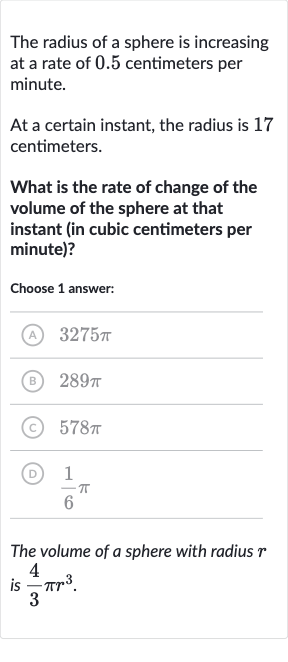AI tutor
Welcome to Bytelearn!
Let’s check out your problem:

The radius of a sphere is increasing at a rate of . centimeters per minute.At a certain instant, the radius is centimeters.What is the rate of change of the volume of the sphere at that instant (in cubic centimeters per minute)?Choose answer:(A) (B) (C) (D) The volume of a sphere with radius is .
Full solution
Q. The radius of a sphere is increasing at a rate of . centimeters per minute.At a certain instant, the radius is centimeters.What is the rate of change of the volume of the sphere at that instant (in cubic centimeters per minute)?Choose answer:(A) (B) (C) (D) The volume of a sphere with radius is .
- Volume Formula Derivation: The formula for the volume of a sphere is . We need to find , the rate of change of volume with respect to time.
- Differentiation with Chain Rule: First, differentiate with respect to time to get . Using the chain rule, .
- Substitute Values: We know (the rate at which the radius is increasing) and (the radius at the instant we're interested in).
- Calculate : Substitute cm and cm/min into to find the rate of change of volume.
- Calculate : Substitute and into to find the rate of change of volume.$\frac{dV}{dt} = \(4\)\pi(\(17\))^\(2\) \cdot \(0\).\(5\) = \(4\)\pi(\(289\)) \cdot \(0\).\(5\) = \(578\)\pi \, \text{cubic centimeters per minute}.
More problems from Solve quadratic equations: word problems
QuestionGet tutor help
